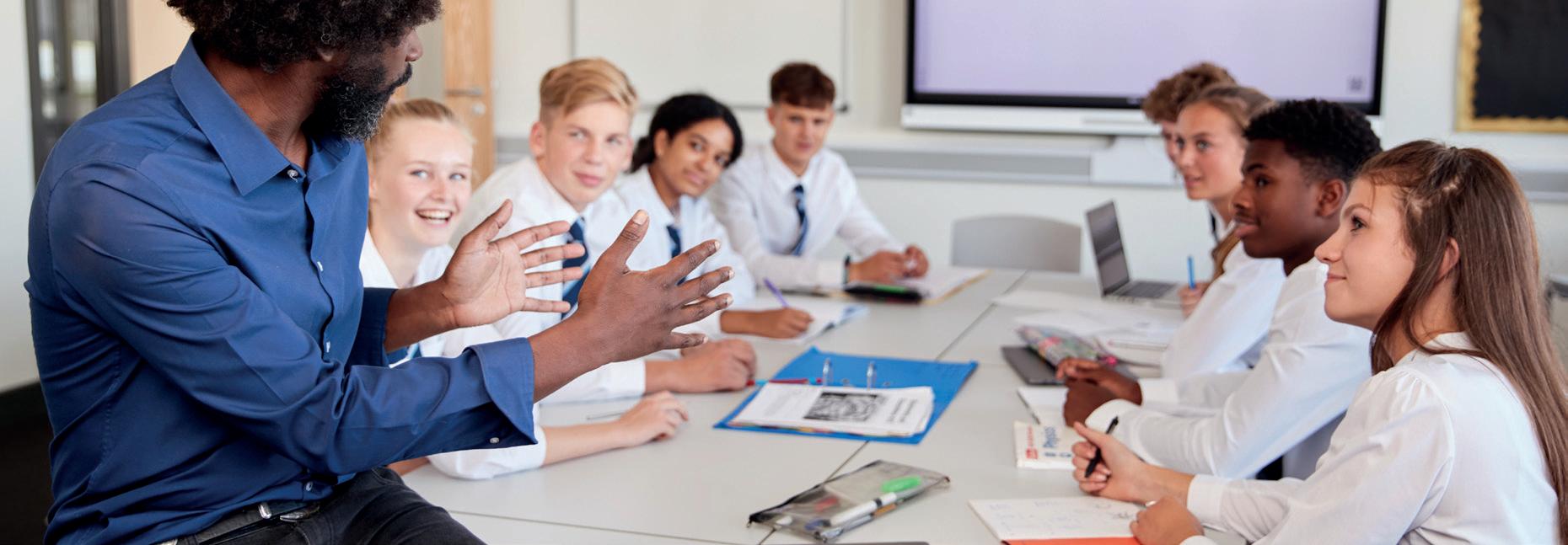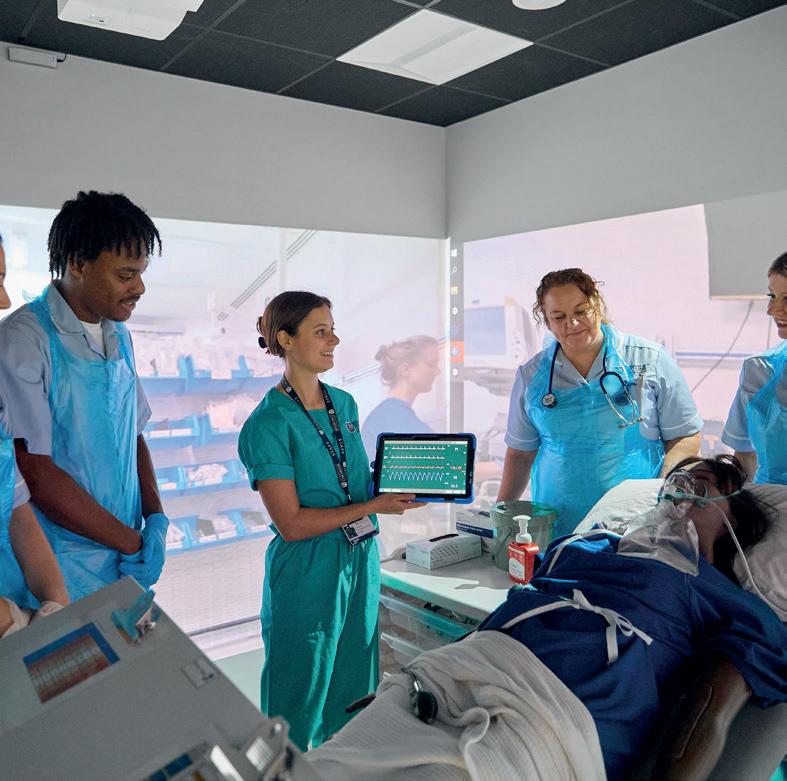Future of Edtech

“While
 Dave Smith, Head of Content, BESA Page
Dave Smith, Head of Content, BESA Page


“While
 Dave Smith, Head of Content, BESA Page
Dave Smith, Head of Content, BESA Page
more promising
How we rethink education to increase the efficiency of learning can improve outcomes, expand opportunities and make education more accessible to every student.
Before Covid-19, conversations about the changing future of education were already underway. In the case of massive open online courses (MOOCs), for example, the technology was ready, and the excitement was palpable; but it took the pandemic to overcome resistance and see schools, colleges and universities having to move online.
Reshaping learning in the classroom

This massive global experiment led educational institutions to rethink their entire approach to teaching and explore how technology such as smart devices, virtual classrooms and artificial intelligence (AI) algorithms could not just enable — but enhance the learning experience. Similarly, at Bett, not being able to bring the global education community together physically forced us to rethink our purpose and find new ways to connect online. We’ve always been a forum for sharing ideas on how technology can help schools and higher education establishments improve educational outcomes; and through the 365 community we built, those conversations can now carry on all year round.
Selecting the right technology for your school Technology offers a myriad of opportunities to track student
Project Manager: Henry Fuller


henry.fuller@mediaplanet.com
progress in real time and deliver learning more efficiently and flexibly. For example, assessments can be tailored according to individual student needs and then analysed to identify specific areas for improvement.

Teachers are not technology experts. Every school, university and college must consider all the resources at their fingertips and weigh up the cost of each solution against the value it will add to the classroom. However, this is no easy task.

Bett has created tools and resources to help educators find the right solution for their learners’ needs, including its new tech-enabled Connect @ Bett meeting programme which empowers them to do so in a fraction of the time. The conference will deliver over 100+ hours of continuing professional development (CPD) accredited opportunities to ensure users are maximising their use of technology.
Taking a community approach

As a community, we’ve also learnt the drawbacks when all learning goes online. To rebuild and thrive in a post-Covid economy, we need both in-person and virtual experience while training and upskilling teachers to ensure they feel confident using the tech purposefully.
Not only do we have a Covid-related learning gap to bridge, but budget cuts, strikes and the cost of living crisis mean innovation and collaboration are needed more than ever.
Business Development Manager: Emma-Jean Edwards Managing Director: Alex Williams Head of Business Development: Ellie McGregor |

Head of Print & Design: Thomas Kent Designer: Aimee Rayment Content Editor: Angelica Hackett O’Toole | Head of Digital Operations: Harvey O’Donnell Paid Media Strategist: Jonni Asfaha Social & Web
Editor: Henry Phillips Digital Assistant: Carolina Galbraith Duarte | All images supplied by Gettyimages, unless otherwise specified
The right type of digital technology can enhance the learning experience for students while benefiting teachers, says Matt Waring, Education Channel Manager, Logitech.

Is technology helping schools rethink the way that pupils learn?
Yes, by giving teachers and students more options. The huge variety of digital tools and resources gives students increased flexibility and empowers them to find their own voice. The pandemic helped accelerate the trend for digital learning.
Overnight, the typical IT use of a school went from 35 minutes a day to three or four hours a day. Blended learning — a mix of face-to-face and remote learning, via digital tools — is here to stay.
What’s your definition of ‘digital learning’?
Any learning that is facilitated or delivered by technology. Even the traditional classroom setting can be enhanced with video conferencing solutions, cameras and microphones. For example, whiteboard cameras allow remote participants to join in with a lesson — but, thanks to AI functions, they also give students in the room a better, clearer view of the board via their own devices. Plus, the lesson can be recorded and played back later.
Meanwhile, individual students can use digital styluses — like pens, but for digital devices — collaboratively, in a way that allows everyone to work on the same document at the same time — accelerating the pace of learning.
Even the learning of individual students may be enhanced with, say, a headset to eliminate background noise and improve their focus, or by picking up their voices clearly if they’re using an app for dictation or language lessons. Plus, eSports and gaming are huge growth areas — and a way for students to develop skills such as teamwork, leadership and strategic thinking through play.
What type of digital learning technology should every classroom have?
Every classroom will have its own requirements. However, educators need to choose the right technology to better understand their students’ needs and deliver improved standards of teaching. Equally, technology mustn’t be used for the sake of it. Its job is to amplify the learning experience, not distract from it.
How does digital learning enhance access, equity and inclusion?
Every learner must be served properly — but it’s also the case that everyone learns differently. For example, rather than type an essay, a student might want to dictate it. Technology enables students to be creative and collaborative but learn in their own way.
How can it benefit teachers?
For instance, webcams are available that auto-focus and auto-adjust lighting, helping teachers make and maintain eye contact with their students during remote learning sessions. That means lessons are more engaging, and teachers are assured that their pupils are listening and understanding. Hand-held presenter tools enable the teacher to move around the room and interact with students while remaining fully in control of lesson content.
What are the challenges to successful digital learning? Expense plays a part. Schools want value for money, but buying the cheapest tech could be a false economy if it has to be replaced after a year or if it doesn’t positively impact the user. They should focus on digital tools that have been developed for educational settings — and built to last.
This type of technology needs to be real-world and classroom-tested. It must be easy to deploy and manage because teachers don’t want to spend the first 10 minutes of a lesson trying to set it up.
How important are design and sustainability issues in this area?
Design is key. We’ve put a lot of thought into developing technology that helps with student wellness. Our tablet cases have keyboards on them, for example, which is better for the user’s posture, enhancing stamina and focus.



And sustainability is a vital consideration. It’s a real issue for young people — as it should be. Schools must work out how to deploy technology in a way that doesn’t negatively impact the environment and use devices that are built with sustainability in mind.
Find out more at logitech.com/en-gb/ education.html

The huge variety of digital tools and resources gives students increased flexibility and empowers them to find their own voice.
The potential of technology resources for learning is huge, but budgets are tighter than ever.
Schools want to provide the best resources they can, and this includes technology. But investing in new equipment isn’t always the answer. Here are some ideas for how you can do more, without spending more.
Assess your existing technology resources
An audit of what technology is being used, as well as by whom and when, will enable you to get more out of items such as laptop trolleys. Scan your software subscriptions for unused or duplicated titles. Busy teachers/edtech leads may not have had time to learn how to get the most out of edtech already on-site. Investing in training could negate the need to buy any new software or hardware. Understanding your education technology usage is vital to working out how to improve it. Tools such as the Naace Self-Review Framework allow you to build a complete picture of your school’s current situation — and to benchmark it against national expectations.
Sweat those technology assets
By upgrading components such as discs, RAM and wi-fi, it’s often possible to double the lifespan of devices. You may also be able to repurpose old, slow Windows devices which
It can be difficult for school leaders to keep up with the latest developments in education technology (edtech). What issues are they facing and what questions should they be asking to get it right?
The British Educational Suppliers Association (BESA) and NAACE have collaborated to produce the ‘Education Technology Briefing Paper – an overview of education technology (EdTech) implementation and use in UK schools 2023’. This briefing paper uses independent data, commissioned by BESA, to provide guidance to school leaders on the purchase, implementation and impact of edtech. It indicates current national trends in edtech and provides key leadership questions to assist school leaders when developing digital strategies.
can fly if using an alternative operating system such as Chrome OS Flex.
Older computers that are removed from design or media studios can be reused — instead of disposed of — in more general areas such as libraries and learning resource areas. Since specialist software is not typically needed, older computers can still be used for web browsing and research.
Let the cloud do the work sustainably

Because cloud software runs in a browser, you can often use cheaper, lower-specification devices to access it. Microsoft 365 and Google Workspace can be accessed via the web, requiring less processing power and disk space. Traditionally, multimedia editing has required high-performance machines. However, web services like Soundtrap, Wevideo and Adobe Express do all of the processing on their servers, meaning that local machines don’t have to.
Moving file storage to the cloud means that you can reduce the size and specification of your servers, lowering costs associated with replacing, maintaining and cooling them. Implementing measures like these can save money, reduce waste and ultimately contribute to saving the planet.
Analysis of schools fulfilment of the Department for Education’s ‘Digital and Technology Standards’ shows that 46% of primary schools are meeting the standards to some or a significant extent; and 71% of secondary schools are meeting the standards to some or a significant extent. The majority of schools have good access to devices and internet connectivity, but there is still room for improvement in the quality and reliability of these services. Many schools also lack robust edtech infrastructure, such as a large, high-capacity wi-fi network.
WRITTEN BY Dave Smith Head of
Content, BESA
Overall, the findings indicate that while schools are making progress in implementing and using edtech, there are still significant challenges and areas for improvement. Many school leaders need further training and support, time to plan and implement edtech initiatives and a better understanding of its potential benefits. In addition, school leaders must balance the need to provide their pupils with access to edtech considering the requirements of current school accountability measures.
The use of edtech in schools is increasing, with the vast majority of schools reporting that they use edtech in their teaching and learning. However, how edtech is used varies. For example, the use of edtech is becoming increasingly common in secondary schools compared to primary.
The report also provides a number of leadership questions for consideration as well as a Quick Audit Tool to help school leaders make informed decisions about their school’s edtech provision.
Findings from the ‘Education Technology Briefing Paper Overview of education technology (EdTech) implementation and use in UK schools 2023’ report will be shared by BESA and Naace at the Bett Show in London, UK on Thursday 30th March 2023. Find out more and sign up at uk.bettshow.com/ agenda-2023
Understanding your education technology usage is vital to working out how to improve it.
Joan Mill, Group Managing Director - International of edtech company, Renaissance, believes that innovative technology when directed by the teacher, is a great educational leveller that can help us ‘see every student.’
What do you mean by ‘see every student’?
impact their time, efficiency, and wellness. Employing technology alleviates some of that pressure, facilitates early intervention and supports learning recovery – while also making the practice of essential skills fun and motivational for students.
Can technology help parents?
Managing Director, International, Renaissance

I say that because technology promotes equity among students. It is a great leveller. Take computer-adaptive assessments that change the difficulty level of questions, depending on the student’s previous answers. Adaptive tech personalises learning; making it easier to see if a child is progressing at the same rate as their peers — and if not, intervene with a different learning style or teacher support so no pupil is left behind.
Do we need to think differently about education provision?
Yes — by putting great technology in the hands of teachers, we are able to positively impact student growth. Technology has been harnessed to improve working practices and customer experiences in other industries. Why shouldn’t it happen in education?
It’s our mission to accelerate learning for all by leveraging the power of cloud-based technology to create educational solutions that support and motivate students, empower and amplify teachers and engage parents.
How does technology support teachers and motivate students?
Teachers tell us that one of their greatest challenges is workload. Balancing competing demands can negatively
Yes, absolutely. Technology can provide parents with visibility of their child’s progress and alerts them of their achievements to help celebrate their successes.
How does data improve assessment?
Data is most impactful when it’s timely and insightful. There’s only so much information you can glean by assessing students once a year with a paper-based test. However, technology facilitates regular assessment, making it easier for teachers to mark work, intervene to make better decisions for students, and generate personalised learning pathways.
What might prevent educators from embracing technology? Anyone who sees technology as ‘the unknown’ and therefore as a threat, may require a mindset change. We know that teachers and educators are the experts. As such, they can and should use technology to enhance and amplify, not replace or diminish the quality of their craft – using software to relieve some of the pressure and personalise learning for all – essentially, see every student.
Used in the right way, technology can empower teachers and motivate students.
‘see every student’WRITTEN BY Tony Greenway INTERVIEW WITH Joan Mill Group WRITTEN BY Clare Marchant Chief Executive, UCAS

Career education has, for some, been the outlier, serving the most tech-savvy users in often low-tech ways. For the benefit of students, the sector and the job market, this needs to change.
Hyper-personalisation and masses of behavioural data now drive our everyday life. Netflix finds new shows, Amazon serves us products for our multiple needs, and we’re all but putty in the hands of TikTok’s algorithm.
So why, in 2023, should young people — who live more in this world than any of us — experience a difficult, manual and labour-intensive process to discover post-18 options, particularly if it isn’t the traditional undergraduate degree route? We are changing this with new digital solutions to help drive better decisions.
In 2019, we launched the UCAS Hub — a personalised, private and productive place for students to carry out and save their research. Each year, more than 1.5 million students use it; by reading and pinning articles, bookmarking courses and saving city guides or accommodation options. The Hub also actively recommends resources to them, based on what they’ve been reading, watching and liking.
While UCAS has always been known for admissions to undergraduate degrees, our driving is parity; all postsecondary options side-by-side. Later this year, for the first time, apprenticeships will be presented alongside traditional degrees — a game-changer for students and teachers alike.
On average, one in five pupils in classrooms across the country (some 1.7 million young people) are falling behind with talking and understanding words1 – an increase of almost 200,000 from pre-pandemic levels.
WRITTEN BY Professor Charles Hulme Founder of OxEd & Assessment
The ability to talk and listen affects our ability to read, write and learn at school. Without a broad vocabulary, children struggle to access and understand all areas of the curriculum. It can affect how we behave, make friends, manage our mental health and even our future careers, with those who start school with poor vocabulary twice as likely to be unemployed as adults.
Keeping track of pupil learning
With the right provision in place, outcomes for these children can be significantly improved. This is why the world’s leading digital media learning company, Pearson, and OxEd & Assessment, leaders in evidence-based assessment apps and interventions, have joined forces to

Presenting students with all their choices in one place will not only transform the apprenticeship offering but create real parity by putting these options side-by-side with undergraduate courses. The Hub will show students the different routes into a single career destination; meaning if a student is interested in engineering, for example, they will see the undergraduate and apprenticeship routes displayed side-by-side.
With so many students making decisions on soft factors — like peer recommendations or parent approval — important choices can sometimes be made without the full picture. That’s why we combine this information with other data — like our Career Quiz which shows the number of vacancies in different careers, salary information and predictions on how this area will grow in the future.
Given that decisions made about higher education are likely to influence future careers and working lives, we need to equip young people and mature applicants with the tools to make them properly now.
Higher education and the labour market are generally blessed with an extraordinary amount of data, within which lies the answers to most of our biggest challenges. If we can be more tech-savvy in our thinking, we can build an environment to improve the lives of students, providers, employers and the entire UK economy.
The impact of this on pupil progress and the widening disadvantage gap has been widely reported, and we know — through studies from the Education Endowment Foundation (EEF)3 and others — that the language, literacy and numeracy skills of primary school pupils have all been affected.
So far, OxEd’s work with over 500,000 children in over 10,000 schools has identified 55,000 children who would benefit from educational support.
ensure more children have access to the right support to reverse this trend. By using evidence-based educational assessments and targeted early intervention, schools can quickly and easily identify children who have language or reading challenges and are in danger of falling further behind. Assessment tools like LanguageScreen and the newly released ReadingScreen provide an accurate profile of each child so that progress can be tracked and targeted interventions, such as the Nuffield Early Language Intervention (NELI), can be used to help close the gap.
It was estimated that during the pandemic, pupils lost over half of their expected days in the classroom2 and around a third of their learning.
As the most well-evidenced early language programme available globally, NELI is supported by teaching handbooks, resources, flashcards, asynchronous training and mentor support. Rigorous randomised controlled trials have shown NELI improves children’s language by an additional 3–5 months, with the positive impact on this and classroom behaviour still seen up to two years later. Through scientifically backed assessments, proven classroom interventions and a deep understanding of how to support teachers, Pearson and OxEd are committed to working together to improve educational outcomes for children throughout the UK.
References
1. https://speechandlanguage.org.uk/media/4287/1-point7-million-young-futures.pdf
2. https://cep.lse.ac.uk/_new/publications/abstract. asp?index=8228
3. https://educationendowmentfoundation.org.uk/news/ eef-publishes-report-on-the-impact-of-the-pandemicon-key-stage-1-pupils-attainment

 WRITTEN BY Les Hopper Product Director, Pearson
WRITTEN BY Hayley White Assessment Director, Pearson
WRITTEN BY Les Hopper Product Director, Pearson
WRITTEN BY Hayley White Assessment Director, Pearson
We’ve returned to brick-andmortar classrooms and exam halls, but our relationship with edtech is forever changed. As aspirations and expectations rightly grow around what edtech can do, it’s insights from schools and technology that are crucial in challenging what’s possible.
Exams onscreen, not on paper
Already, these insights are changing how exams work. Approximately 65% of teachers and school leaders in a 2021 Pearson survey said they’d be interested in adopting onscreen exams in the next four years if they were available. So, we’re making the hypothetical a reality.
Building on extensive research, trials and our onscreen mocks service, this is the second year that thousands of students will take onscreen Pearson Edexcel GCSE and International GCSE exams. Going beyond moving exams to a device, the onscreen platform also enables students to personalise their exam experience — from accessibility options and customising the formatting to a choice of tools for planning and reviewing answers.
But are onscreen exams making an impact? About 90% of students in our onscreen International GCSE (9–1) English Language A pilot think their school should offer more onscreen assessments in the future.
Wayne Ridgway, Headteacher of Senior School at the British School of Bahrain, explains: “It’s been a fantastic experience for us as a school, but also for our students who were absolutely delighted to work in a way that they felt most comfortable with.”
Exams should reflect technology young people are familiar with and will use in the future, with feedback from our GCSE (9–1) Computer Science students saying that our onscreen coding exam “makes sense … It’s a lot closer to a real-world scenario working as a software developer and tests your problemsolving skills.”
Making data, assessments and insights work harder
Alongside providing results, our exam services also offer teachers data analysis pinpointing students’ strengths and areas for improvement. The power of such insights to enrich progress should be available at every stage of learning.
That’s why we launched a new data-driven digital service this year: ActiveHub. Bringing together assessments, independent practice and data insights in one place, the platform is underpinned by an Insights Dashboard that teachers can use to see results, analysis and trends.
Comparing ActiveHub’s Insights Dashboard to what schools have been using historically, Nicky Crum,
Science Improvement Lead at STAR


Academies Trust, says: “There’s so much you can gauge. It’s not just a number from a test. This is down to actual detail of knowledge gaps … It gives time back for teachers, time for them to put more emphasis onto their planning of learning and planning of individualised needs.”
Alongside benefits for teacher workload, such technologies can support teachers in personalising learning and intervention. Based on students’ results, ActiveHub also suggests next steps, which teachers can use to guide student progress based on what they know will work best. What’s more, student-facing views of the results and feedback mean students can understand how they’re doing and feel empowered to take an even more active role in their learning.
Taking these insights further
By harnessing edtech and insights, we, as an education community, can personalise learning and assessment like never before. We can work together to break down barriers to technology access in all its forms — from inclusive design to tackling the digital divide.
The result: every student can experience a learning and assessment journey that’s as unique as they are. Here’s to continuing the conversation as we seek to shape our ever-changing relationship with edtech for the better.
If knowledge is power, then insights and data are supercharging transformations in learning and assessment.Paid for by Pearson
Schools are using innovative digital assessment tools to help them get a complete picture of their students’ wellbeing, at individual, class and even whole-school levels.
There are three reasons why schools should understand their students’ wellbeing, says Dr Irenka Suto, Assistant Director of Assessment at the Cambridge Centre for Evaluation and Monitoring (CEM), which provides baseline assessments for children of all ages and is part of Cambridge University Press & Assessment.


Why student wellbeing is important
“First, children spend around 15,000 hours in school, which is a big proportion of their lives,” she explains.
“We want them to feel well, safe, energised, excited about the future and good about themselves. Second, encouraging them to talk openly about wellbeing equips them with broader social and emotional skills which they will need in life. Third, children with higher levels of wellbeing perform better academically.”
It’s well-documented that the Covid-19 pandemic took a toll on young people’s wellbeing by starving them of social interaction. “Social interactions are critical,” says Suto. “They fulfil a core psychological need of relatedness and belonging. If young people are feeling low, they are not going to want to engage with their peers, which makes the situation worse. And they are more likely to play truant, which impacts their education.”
Approximately 10% of the population has dyslexia. That could mean up to three students in every class. Although, we know that these numbers are likely much higher — now, edtech can support students with dyslexia.
When I take my glasses off, I find it hard to read; and I’d really struggle to drive a car. It’s not an intelligence thing, it’s a vision thing. Dyslexia is similar. With the right tools, all students can thrive.
A recent survey by global technology company Texthelp highlights the true scale of literacy challenges in the UK. The report also reveals that technology is key to breaking down literacy barriers in education.
To help schools discuss and promote the wellbeing of their students, CEM developed a digital assessment tool — the Cambridge Wellbeing Check — grounded in research from the University. It takes around 20 minutes and involves students answering 22 carefully developed multiple-choice questions. Suto stresses that the tool does not diagnose mental health problems among individuals; but it will produce a series of reports to give teachers a complete picture of wellbeing at individual, class and even whole-school levels.

“If any answers raise concern about an individual student’s wellbeing, a teacher can follow up with them — in strict confidence,” says Suto. “Teachers can also discuss answers — anonymously — in a follow-up lesson to pinpoint general areas of wellbeing that could be improved for the class as a whole.”

The Cambridge Wellbeing Check is suitable for children aged 7–18 and is being used in schools in the UK and internationally. Suto hopes it will help anyone struggling with low levels of wellbeing but not confident enough to ask for support. “It’s a way to give every student the chance to indicate how they are feeling and for schools to provide support and interventions,” she says.
needing a teacher for help with reading or spelling. This can reduce confidence and cause problems with focus. Tools such as digital highlighters and voice notes help learners to study more independently.
Technology works best when students can use it as part of their normal way of working. This includes in class, at home and during exams, where students with dyslexia may qualify for access arrangements — for example, to allow a computer to read exam papers.
Students with dyslexia have a choice in how they learn
With the right tools, learners with dyslexia can choose how they engage with tasks. They can use text-to-speech to have words read aloud and track the words on a screen to increase comprehension. They can use voice typing and prediction to get their ideas straight onto the page. Often, we see this leading to an increase in the range of vocabulary used, as they don’t have to worry about spelling.
Learning happens everywhere
When doing homework, students with dyslexia may find themselves
Thinking of a tool like text-to-speech, you’ll agree that it’s great for dyslexic students. But it’s also useful for that A-Level student working towards a history exam. They can listen to questions to aid understanding or listen to complex answers to proof and improve.
By making these tools available, students can choose when to use them. This will also help reduce the stigma for students who need the tools.
Students don’t just leave school and leave their dyslexia behind. Technology can give them the tools they need to overcome barriers and unlock the potential of dyslexic thinking.
Children with higher levels of wellbeing perform better academically.WRITTEN BY Tony Greenway
An analytics automation company is responding to the market’s data literacy shortages by upskilling a new talent pipeline ready to deliver value to businesses from day one.
The demand to drive insights from data has accelerated in the last two decades, explains Libby Duane Adams, Co-Founder and Chief Advocacy Officer of analytics automation company, Alteryx. “Data is everywhere; and today, every department in every business is trying to figure out how to work with data,” she says. “Twenty years ago, data was thought of as a coder’s or engineer’s world. It wasn’t thought of at the scale we have today.”

This scenario presents a paradox: an urgent need for data talent to close the widening skills gap and an opportunity for anyone seeking to upscale their career. “Now is the time for people to invest in themselves, their skills and their education,” says Adams. “It’s no longer acceptable to only know how to work with a spreadsheet. These are not the appropriate data skills for today and tomorrow.”
Nowadays, 82% of all jobs in the UK list digital skills as a key requirement, yet employers struggle to fill a third of those vacancies, costing the British economy £63 billion per year in GDP. The problem is a lack of digital competency in the talent pool, warns Adams. “Unfortunately, there are not enough schools offering these skills in modern data analytics,” she says.
“It’s employees that will close the talent shortage gap with the right skills. That’s why it’s so important to work with universities, higher education institutions and career-changers.”
In response to data skill shortages, Alteryx developed a no-cost data analytics educational programme called SparkED. The free, self-paced programme is designed to put its easy-to-use, end-to-end analytics automation platform in front of higher education students and individual learners in the workplace and on the job market.
These certified courses are for anyone, Adams insists. “Modern analytics is for people with a coding or non-coding background,” she says. “Educators have to think about data analytics the way business leaders think about it, which is code-free. That’s why we’re so adamant that both code-free and code-friendly practices must be taught.”
To meet a diverse demand, Alteryx has created different learning pathways, such as courses in predictive analytics and spatial analytics, which apply to a broad range of careers. “Those learning about data analytics are able to come into employment and be productive from day one,” says Adams.
“These efficiencies from the new hires are positively impacting businesses. From an employment perspective, it’s giving future employees a leg up because they’ve got the skills that companies are looking for.”
As well as upskilling the talent pipeline, senior managers need to embed a culture of continuous learning within the current workplace. “Business leaders want to support employed individuals who may already have the business acumen in marketing, supply chain, finance and so on,” says Adams.
“These leaders are taking steps to invest in upskilling their current employees across all departments because they know they have to drive the business faster and more efficiently through data analytic automation. And they need to be able to do that now.”
The data talent shortage isn’t just a UK problem, warns Adams. Business leaders across the world are struggling to find the right talent to analyse data and apply relevant findings. Navigating the challenge requires acting now to adopt data learning right across the business, she advises.
“This is an opportunity now for leaders to transform their businesses into a data-driven company and take advantage of data assets to be able to run the business better and make truly informed decisions.”
If you’re interested in learning the analytic skills that can turbocharge your career, find more information on a free 90-day trial: alteryx.com/ sparked/
It’s no longer acceptable to only know how to work with a spreadsheet. These are not the appropriate data skills for today and tomorrow.INTERVIEW WITH Libby Duane Adams Co-Founder and Chief Advocacy Officer, Alteryx WRITTEN BY Sarah Brown
With the estimated school absence rate for the 2022–23 academic year hitting 7.8% in the UK, concerns about children’s severe and persistent school absences since the pandemic have been growing.
Absence is an issue for education systems across the world — but could some of the digital tools put in place during lockdown help tackle this problem post-pandemic?
Challenges lead to school absences
WRITTEN BY Sarah Horrocks Freelance Digital Learning Consultant and Former Director of the Connected Learning Centre

Åsa Lindgren teaches in a Stockholm secondary school supporting young people who experience challenges attending classes regularly. She describes examples of teenagers whose attendance has increased through access to digital learning activities from home, together with personalised support.
One girl who’d stopped coming to school began to re-engage with activities in the digital classroom. By talking through her learning in twice-weekly calls with Lindgren and reading the tasks on the learning platform together to check her understanding, she ultimately felt confident enough to return to school to complete her national exams.
How to avoid increasing absence rates
“Instead of struggling to look for clues when they’ve zoned out, they can go back and review the digital classroom. It’s helpful if they have constant visibility of learning — including links to video clips and references, so they can check if they’ve missed anything,” explains Lindgren.

“It’s important for all students — whether with good or poor attendance — that teachers share their plans and future work to be covered clearly in the digital classroom. It’s not just for setting tasks and homework. Children need to feel in control of their own learning and be involved in a democratic partnership with their teachers,” she warns.
Adapting to student circumstances
School absence can also be due to circumstance rather than confidence. In Jordan, the number of refugee students from Syria means that school takes place in two shifts: one set of pupils and teachers use a school building in the morning, then a different set in the afternoon.
The Connected Learning Centre in London worked with UNICEF and the Ministry of Education in Jordan on ‘Learning Bridges,’ a blended learning approach developed as a response to the Covid-19 pandemic. In 2022, Learning Bridges reached 600,000 students in over 70% of schools, including refugee camps.
For children in Jordan, digital access to learning means they can learn for longer each day. What started as an emergency intervention responding to the needs of children learning from home continues to enrich students’ learning and improve the quality of education in Jordan’s public schools.
Sarah will be speaking at a session on ‘Computational Thinking: Learning from digital practice in European pre-school and kindergartens’ at Bett 2023. Scan the QR code to see the full agenda.
School absence can also be due to circumstance rather than confidence.
State-of-the-art training gives the next generation of nurses and health workers the skills and competencies they need to deliver safe and compassionate care to their patients.
Healthcare professionals are the lifeblood of the NHS — although, currently, they are in short supply. “There’s a huge deficit of trained healthcare staff in the UK,” admits Dr Nita Muir RN, Head of the School of Nursing and Allied Health at the University of Chichester. “We aim to expand the available pool of home-grown nurses and allied health practitioners and develop those currently working in the sector.”
With health and social care becoming more integrated, the School of Nursing and Allied Health — a state-of-the-art facility which opened in September 2021 — is working with its clinical partners to deliver education in the

most proficient way possible.
Students spend half their time learning academically and half gaining crucial clinical experience in the clinical environment AND simulation-based learning. For example, the school has a six-bed unit which recreates a ward environment; a GP practice room which recreates a primary care environment; and a fully functioning interactive flat which recreates a community environment.
Students encounter actors within these settings who act out situations and patients with different symptoms and unpredictable healthcare challenges. In the ward environment, students have access to a robot patient and are confronted with a variety of facilitated scenarios, including emergency situations.
“A key part of learning is to give trainee nurses exposure to complex and, sometimes, extremely stressful situations they will encounter in clinical practice,” explains James Wilson, Senior Lecturer in Nursing, National Teaching Fellow, University of Chichester.
“By carefully managing this in the safe space of a simulated environment, students can develop their professional knowledge and decision-making skills. It also means we rely less on placement learning and, crucially, keep patients safe — which is our main driver.”
Enhanced learning and virtual experiences
New technology powers facilitated learning environments and plays a significant part in training. For instance, the school has an immersive learning room — a physical space which projects different healthcare scenes (such as A&E and roadside care) onto its walls. It also uses virtual reality (VR) headsets allowing all students to enter virtual medical scenarios at the same time. However, Dr Muir stresses that technology must always be applied appropriately to enhance learning — and not used simply because it is available. “Tech does not replace the essence of clinical learning,” she says. “As educators, we never forget that our objective is to develop a highly proficient workforce who can offer safe and compassionate care to their patients.”
the phonics framework that it had been using since 2007, creating a new wave of competition among phonics programme publishers, who are racing to fill the void.
Government policy changes and modern development techniques have enabled a wave of new innovative phonics instruction tools.
Technology creates abundance,” says Gilbert Jolly, CTO of educational publisher, Jolly Learning.
“If you’re a teacher, it’s great that there is a wealth of content online to use in your lessons. The problem, though, is that abundance creates noise. Teachers need to cut through that noise, spending precious time identifying and preparing the right content.”
“If the content you’re using is not engaging pupils, or the software isn’t clunky or disconnected, it just makes teachers’ busy lives more difficult,” insists Jolly. “It’s why any publisher developing educational technology must make products with the end users in mind. That means working



closely with teachers, testing their products in schools, and creating a tight feedback loop so that refinements can be made. It also means making the products comprehensive so that teachers don’t need to search around for additional content.”
Democratising the market for phonics teaching Phonics is the leading way of teaching reading and writing by teaching the letter sounds, then teaching children the core skills of blending and segmenting that allow them to read and write.
With Edtech, the phonics space is ripe with opportunity. Recently this has been compounded, as the Department for Education retired

For instance, Jolly Learning — publisher of Jolly Phonics, the original programme for phonics teaching — has launched Jolly Classroom, a modern, multi-sensory, interactive lesson platform with games, songs, and a multitude of activities for teaching children with Jolly Phonics.
The right tools for your students
Any edtech developer worth their salt must create comprehensive solutions that simplify life for teachers and make learning fun, says Jolly. “If they have the right tools, teachers won’t have to do lots of lesson prep — they can get straight into teaching. Pupils will be involved and invested because the lessons are engaging and fun. The best way for children to learn is for them not to realise they are learning.”
Thanks to the way technology has evolved, it’s now easier and less expensive for developers to create compelling edtech products. “Ten years ago, the cost of making an app that worked across every platform — from smartphones to digital whiteboards — would have been exorbitant,” says Jolly. “Now, small publishers like us can compete with big publishers and make compelling and beautiful educational products.”
HowINTERVIEW WITH Dr Nita Muir RN Head of the School of Nursing and Allied Health, University of Chichester
How technology is helping teachers make learning to read fun and simple
When thinking about educational technology (edtech) to support our special education needs or disability (SEND) learners, we need to think about everything that might sit below the surface.
One of our most famous exports in Belfast is the Titanic. If we think about that notorious iceberg, we know that only 10% was visible above the waterline, yet the 90% that the captain needed to know about was invisible.
This is also true of our pupils if we think about the percentage with identifiable or, perhaps, obvious individual needs. Any teacher will tell you, however, that this is not reflective of the students who need support — those who struggle silently or those who simply learn differently.
We need to think about the stigma we apply when we give a certain subset of learners access to technology. The branding of tools as ‘assistive technology’ can create barriers for those who don’t want to be labelled.
During the extended periods of remote learning, we saw a quadruple rise in the use of assistive technology. That’s because everyone found a benefit. We need to ensure there is equity of access to the same tools for all learners to use when they need them.

We need to provide students with tools that can help them understand and be understood in different ways.
When thinking about text-to-speech as a tool to support dyslexic students, we forget those under the waterline who could also benefit. Reading aloud helps to reduce screen time, with understanding new topic content and with revision. By giving everyone access, all learners can benefit.
Design with technology in mind

Start designing lessons with your toolkit and students’ needs in mind. Think about the format of your classroom activities and the instructions that go alongside them.
Could you provide instructions in multiple formats (written and oral, for example)? Could you provide a list of terms and their meanings ahead of presenting new topics for students to understand, before time, what new words and language mean? If the answer is no, edtech can now put this in the hands of every learner with ease.
The most important thing to remember when using edtech is to provide opportunity. We can design learning well and select the right tools, but we need to give our SEND students the opportunities to use them.
WRITTEN BY Patrick McGrath Head of Education Strategy, TexthelpWe need to ensure there is equity of access to the same tools for all learners to use when they need them.
Going forward, people will need better data skills to thrive in their personal and work lives. That’s why data literacy needs to be further up the educational agenda.
Everything we do — from shopping to banking or updating our social media accounts — is data-driven, and we all have digital devices. Making sure that young people gain the requisite data skills is essential, argues James Reid, Head of Services at EDINA, a centre for data and digital expertise at the University of Edinburgh.
Making proper use of data
“On one hand, it’s an exciting time because the pace of technological change is unbridled,” he says. “On the other, data literacy is sometimes perceived as hard to teach or needing very complex knowledge of statistics or coding.”
Good data literacy teaching is therefore vital, says Reid. Indeed, he believes that fun data skills — such as handling data, finding patterns and collecting information — should be taught at the earliest stages of education. However, he concedes that teaching data literacy to older students can be challenging, largely because data is hard to contextualise.
To help address these issues, EDINA has developed a user-friendly, cloud-based platform, Noteable, which allows teachers to create and share coding lessons to help pupils analyse data and draw their own conclusions from it. “Coding is the next big thing,” says Reid.

“Students will have to know how to program and manipulate data if they are to be fit for the new workplace.” Platforms like Noteable are ideal tools to learn not just coding but also good data handling techniques, data etiquette and ethics.
Using maps to bring data to life and engage students
There is another impactful way to contextualise data, notes Reid. You simply put it on a map. “Maps are a great way to engage children and young adults,” he explains.
“Particularly if it’s a map of their local neighbourhood. For example, a map can tell a pupil that the field they cycled past this morning was once the site of a coal mine. What’s more, maps that have been moved into the digital realm can be overlaid with data from different sources which contextualises complex issues and brings a bigger picture to life.”
It’s why EDINA has developed two online map and data delivery services for education and for research: Digimap (which is now 23 years old) and Digimap for schools.
of game-based play is a way to get children interested in subjects across the curriculum, and it also gets them communicating with each other.”
Problem-solving and constructive critical thinking
Alfonsina Cinzia Troisi, Matatalab Certified Educator (MCE) and Genially Ambassador, agrees that this type of technology can have a powerfully positive effect in classrooms. “First of all, it’s a way for teachers to deliver didactic content,” she says.

Educators working with early years and primary school pupils may want to use technological tools to make lessons more engaging. However, it’s crucial to distinguish which tools are most useful and valuable for children in those age ranges. For example, digital tech is available to help children as young as three develop elementary coding skills.
One company, Matatalab, has developed hands-on programming robots that kindergarten and primary school pupils can manipulate to explore and create their own stories, scenes and game projects.
Using directional arrows, children guide the robot through a path on a themed map. As their learning progresses, they can use the robot to complete more complex tasks using more complicated logic.

This isn’t about teaching young children programming, explains Anna Jie Zhou, Head of Education at Matatalab. Instead, the idea is to give them technological confidence and encourage computational thinking through play.

“When young children play with the robots, they don’t know they are coding,” explains Zhou. “They just think it’s a toy they are playing with — yet they are controlling the robot through coding. This type
“Second, it develops problem-solving and constructive critical thinking in children, which are essential soft skills. At the kindergarten and primary school levels, we use storytelling to address fundamental concepts, such as respect for human beings and the environment. We talk about respecting rules at school, recycling, etcetera — and play with these concepts to create a story that will then be interpreted by the robots.”
Troisi believes this type of easy-touse tech is a way to democratise early-stage education. “That’s because it aims to involve all children — without any distinction or any exclusion, precisely because it is simple and intuitive,” she says.
“Children can shape a learning path based on their learning pace, which is a beautiful thing because they can put their own ideas into practice — not just the teacher’s. It represents a truly powerful learning tool.”
Helping children as young as three develop elementary coding skills
Maps are a great way to engage children and young adults.INTERVIEW WITH James Reid Head of Services, Edina WRITTEN BY Tony Greenway WRITTEN BY Kelly Nicholls CEO, TechSkills

With a growing number of young people worried about the financial impact Higher Education will have on them long-term, many are looking for alternative routes into careers that will allow them to ‘earn and learn.’
The Government’s Apprenticeship Levy is a tax on employers with a wage bill of over £3 million per year, allowing businesses to reinvest back into their workforce in the form of apprenticeship training while allowing the apprentice to study fee-free. With financial pressures growing on everybody, it is no surprise that apprenticeships saw an 8.6% increase in learners in the 2021–22 academic year.
Growing career opportunities in tech
In the tech sector in particular, big employers such as Amazon, BT, TCS and IBM are partnering with TechSkills as they look to plug the digital skills gap in the UK. From cybersecurity to game design, there are so many exciting roles within tech — but not enough people with the right skills to fill them.

TechSkills is employer-led and not-for-profit. They accredit learning pathways — including apprenticeships, degrees and shorter training programmes — that are designed to give employers access to talent.
Anyone can have a career in tech
If we are to address the skills gap this country faces, we must ensure that a career in tech is open to everyone, regardless of background, race or gender. The under-representation of women is stark, with just 19% of tech workers in the UK identifying as women and only 22% are tech directors, according to a report by Tech Nation.
Diversity and inclusion are paramount — not just because it’s right, but because it also allows companies to foster a creative and diverse group of talent that will develop and create new and innovative ideas.
Find a career in tech that suits you


To encourage people from all backgrounds to explore a career in tech, we have developed a Careers Toolkit so that all young people can explore the types of roles that might suit their personality type and interests — and learn how to get there.


The world of tech presents a huge opportunity, and TechSkills can help ensure that every individual can benefit and every organisation can flourish with the talent it needs.

If we are to address the skills gap this country faces, we must ensure that a career in tech is open to everyone, regardless of background, race or gender.
With financial pressures growing on everybody, it is no surprise that apprenticeships saw an 8.6% increase in learners in the 2021–22 academic year.
Effective online safeguarding solutions — featuring real-time alerts — can help schools integrate the management of pupils’ digital behaviour with offline pastoral care.
On the one hand, the internet is a portal to a fascinating and endless source of knowledge. As such, it’s an indispensable learning tool. On the other hand, it’s also the Wild West.
Online safety for students matters
Unmanaged, unfiltered and unpoliced internet access can pose a serious risk to children and young people. Making sure that pupils are unable to view harmful/explicit content on school networks is a challenge for many education providers.
“There is an increased use of digital devices among school children and young people,” explains David Tindall, CEO of Schools Broadband, a company that delivers fully managed internet services specifically designed for educational settings.
Under The Department for Education’s statutory safeguarding and child protection guidance (Keeping children safe in education, updated in 2022), schools and colleges must appoint an appropriate staff member as their Designated Safeguarding Lead (DSL). This might be easier for larger schools and Multi-Academy Trusts (MATs) that can deploy individuals solely dedicated to a safeguarding role.
It can be harder for smaller schools and primary schools where resources are stretched. Plus, staff may not have the understanding or the skillsets to effectively manage pupils’ internet activity,” says Tindall. “Online safeguarding involves a lot of work.”

importance of real-time safeguarding alerts

Under government guidance, it’s mandatory for schools and colleges to have appropriate IT filtering and monitoring systems. “We must stress that ‘filtering’ and ‘safeguarding’ are two very different things,” says Tindall. “A filtering system filters out harmful content to make it inaccessible; a safeguarding solution alerts staff to harmful content that children are attempting to look at.”
For example, an effective safeguarding system will raise the alarm if a pupil searches for information about suicide, self-harm or terrorist-related activity. “This behaviour can often be a cry for help,” says Tindall.
“It must be highlighted immediately because time may be of the essence. The problem is that many safeguarding solutions will flag up the problem in a report days later — by then, the pupil in question may have attempted to view the information again.”
With this in mind, Schools Broadband has developed an online tool — the Digital Safeguarding Incident Management Platform — to help schools integrate the management of their pupils’ digital behaviour with offline pastoral care.

The platform works alongside the company’s existing content filtering solution and reporting engine and filters by URL — rather than simply blocking words — which is more effective. Plus, it provides online protection for pupils who are using school-enabled devices at home. Crucially, however, it also can send real-time alerts should a web search be made that flags a concern. Additional reporting tools enable staff to identify concerns and trends, share information and intervene immediately whenever a child/young person needs help.
“Safeguarding leads should manage and respond to data in real time,” says Tindall. “By recognising patterns and trends in search histories, they can prevent pupils from doing something that may cause harm to themselves or others.”
Naturally, innocent mistakes can be made; so the system can put a user’s internet activity into context and identify mistyped searches, preventing unnecessary safeguarding interventions. If an incident occurs, a digital auditing trail is available to highlight the action taken by the senior leadership team.
Tindall admits that more has to be done to keep children safe online. “Young people have to be taught the facts about internet safety by schools and parents,” he says. “Safeguarding platforms like ours are not a silver bullet. However, if they stop just one child from coming to harm, then it’s technology that’s absolutely worthwhile.”
Unmanaged, unfiltered and unpoliced internet access can pose a serious risk to children and young people.INTERVIEW WITH David Tindall CEO, Schools Broadband WRITTEN BY Tony Greenway
Aaron John and George Metcalfe, the co-founders of Tes-backed student wellbeing service, Tranquiliti, work with schools to build cultures for wellbeing and provide teachers and pupils with the resources needed to flourish.



What inspired the creation of your wellbeing technology? We both had difficult experiences at school, particularly over the lack of wellbeing provision. After working in schools during a postgraduate course in social innovation in 2017, we then decided to create Tranquiliti. We wanted to see how we could help young people develop their own wellbeing while supporting schools to create environments where all students feel supported.
What challenges are schools facing in supporting pupil wellbeing? When we started research in 2017, only one-quarter of pupils with mental health issues were receiving the support they needed. Then, Covid-19 came along and made the problems far greater, with schools often first-line responders for these issues.
The problem for schools is they are in a state of firefighting, and they sometimes lack the capacity and understanding to know how to respond. Only 40% of teachers feel sufficiently equipped to teach young people who have wellbeing concerns. Schools want students to have the skills to look after their own wellbeing, and they want teachers to have the confidence to support wellbeing in their classroom, so that’s what we help to do.
How does technology help schools provide support to students? Technology is everywhere, for better or worse, so the solution lies in making technology part of a positive engagement with wellbeing.
We often ask: Why is technology not being used within education to provide personalised guidance to students and teachers for wellbeing, and to help them access the materials they need?

What barriers do schools face in implementing technology to support wellbeing? Effectively embedding a new piece of technology in schools is not straightforward, and they need help from companies like ours in order to achieve this. Our platform works across all devices, but there is also a discussion going on at the moment as to how schools can limit the negative impacts of phones while embracing the potential benefits and helping pupils form healthy habits.
How does your technology help schools overcome challenges and barriers? Our service puts student wellbeing at the heart of secondary schools. Through our app, every student takes five minutes each week, at home or at school, to answer questions about how they are feeling. The service then generates insights for students, teachers and school leaders and suggests resources to each individual based on those insights.
All our resources are being developed alongside a community of leading wellbeing practitioners. So, through these insights and resources, we build understanding and confidence around wellbeing across the school community and develop the ability to be truly proactive.
Only 40% of teachers feel sufficiently equipped to teach young people who have wellbeing concerns.